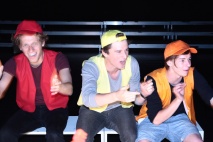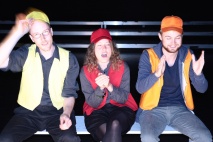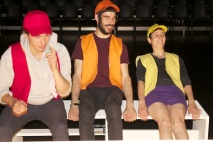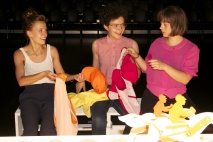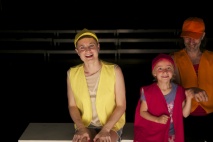Kentucky Derby: Unterschied zwischen den Versionen
Bilex (Diskussion | Beiträge) Keine Bearbeitungszusammenfassung |
Keine Bearbeitungszusammenfassung |
||
| (52 dazwischenliegende Versionen von 2 Benutzern werden nicht angezeigt) | |||
| Zeile 1: | Zeile 1: | ||
{{ProjektInfoBox | {{ProjektInfoBox | ||
|name | |name=Kentucky Derby | ||
|status | |status=stable | ||
|image | |image=IMG 4726.JPG | ||
|description = PostInteractive Horse Race | |description=PostInteractive Horse Race | ||
|author | |username=Bilex | ||
|author=A.B. | |||
|platform=Gallop | |||
|update= | |||
|platform | |tags=Bewegung und Mechanik, | ||
| | |||
| | |||
}} | }} | ||
== Information == | == Information == | ||
''Kentucky Derby'' is a modification of the well known fun fair game of the same title. In contrast to the original game, ''Kentucky Derby'' provides a genuine interactive situation while concealing the definite mechanism of interaction and feedback. | |||
In the absence of an interface device the participants start to discover ways of interaction to speed up their horse in order to become a winner. The movement of the horses is neither random nor they are controlled by an algorithm that is proccessing sensor-generated input data. ''Kentucky Derby'' works with a performative closed-loop system: The participants are observed by cameras and a person outside the room determines the game. Next to positive feedback (horse is going forward) the participants can be penalized by reversed movement, which is not possible in the originale game. <br /> | |||
As most participants are familiar with interactive art, body and hand movement, clapping and shouting the color of the team they have chosen before, are common approaches to get into the inner working of the game. | |||
<gallery> | |||
IMG_0247.jpeg | |||
Img 0430.jpg | |||
</gallery> | |||
==Mechanics== | ==Mechanics== | ||
* '''Drive Concept'''<br /> | |||
To get close to the original game, it is important to copy the silly action of the horses which mainly consists of head and tail movement. After rejecting several drive concepts using rods and wheels I decided to use a revolving timing belt. This solution is able to kill two birds with one stone: The belt is connected to the horse for forward motion, but on the way back it takes a roundabout way through the body to bring rotation inside the horse. All mechanics are hidden inside or behind the body to provide a magical effect of movement. "''How is this working?'' ''I don't know, but it looks good!!''" | |||
* '''Linear Guiding'''<br /> | |||
As there is no need for high precision or handling of high speeds or big loads, a plastic slide-guidance (Igus DryLin®-N 40mm) was chosen. Though there is no need for oil or grease, some WD40 means smoother operation. | |||
To save money most bearings are friction-based bearings that I got from IGUS as free samples. They work quiet nice, but mounting can be difficult. For proper operation the clearance of the bore needs to be very little. | |||
* '''Motor'''<br /> | |||
''Kentucky Derby'' consists of three closed-loop stepper motors (Nanotec PD4-N6018L4204). As an integrated plug & drive motor, the complete electronics with the motor controller and encoder are contained inside a single housing. The motor can be controlled by sending ASCII-commands via RS-485. The integrated controller offers several functions like positioning, ramping, motor current and speed adjustment. Using industrial grade gear is not only fun, additional electronics and programming become obsolete. Only a few lines of code are required for sending ASCII-Commands via UART to get the motor running. To be honest, the chosen motor is a bit over-the-top.. it provides 3,55Nm of torque and a max. power of ~100W (@48V /375rpm). As the torque is quiet big, the current for proper operation can be lowered to 30% of rated current without losing steps or running into other problems. In operation with little current the motor sound is decreased. When running the motor detached from the mechanics it is super-silent, but after mounting it on the wooden frame, the resonances and vibrations are amplified dramatically. At least, ''Kentucky Derby'' can be quiet loud in operation! Things to learn here: Use mechanical-decoupling to keep resonances inside the motor. Using such a [http://en.nanotec.com/products/1117-daempfer-fuer-anbauflansch damper] might help..? | |||
<gallery> | <gallery> | ||
IMG 0217.jpeg | |||
IMG 4737.JPG | |||
IMG 0220.jpeg | |||
IMG 0186.jpeg | |||
IMG 4727.JPG | |||
IMG 0176.jpeg | |||
Img 0425.jpg | |||
</gallery> | </gallery> | ||
== | ==CAD & Manufacturing== | ||
<gallery> | ''Kentucky Derby'' was designed with Autodesk Inventor. The horses were done with the [https://www.das-labor.org/wiki/CNC-Fraese CNC-Fräse] and are made out of 19mm MDF. To achieve a homogenous and glossy finish, several layers of primer and paint were applied. The riders (3mm plexiglass) and the wave-style track cover (3,5mm MDF) were laser-cut. Most mechanical parts were manufactured with the help of the workshop of the physics department at my university. | ||
<gallery > | |||
Render1.jpg | |||
Render2.jpg | |||
Render3.jpg | |||
Img 0405.jpg | |||
Img 0407.jpg | |||
Img 0408.jpg | |||
</gallery> | </gallery> | ||
== | ==Electronics== | ||
As the used motors have their own control units, the amount of additional electronic components is very little. A Teensy-Board is used to communicate with the motors. It receives data via USB and sends ASCII-Commands to the RS-485 bus. A MAX490 converts the UART output of the uC to RS-485 standard. To take a picture of the winner, a small reed-relais triggers a DSLR camera when a horse is crossing the finish line. To avoid long USB cables a OpenWRT based Wifi TCP/USB link is established. (See ''helpful links'' for more information!) | |||
<gallery> | <gallery> | ||
IMG 4735.JPG| Teensy Board | |||
</gallery> | </gallery> | ||
== Competitors & Winners == | == Competitors & Winners... == | ||
<gallery> | ... while being part of ''Kentucky Derby''. Everyone is eager to finish first! | ||
<gallery widths="213" heights="142" mode="nolines"> | |||
Viewer1.JPG | Viewer1.JPG | ||
Viewer2.JPG | Viewer2.JPG | ||
| Zeile 65: | Zeile 76: | ||
</gallery> | </gallery> | ||
== Video == | |||
There are two videos available: | |||
== | A '''[https://vimeo.com/146559598 TRAILER]''' and footage of a '''[http://vimeo.com/131023958 reference run]''' | ||
== Thanks to... == | |||
... these companies which supported this project by providing discount or free samples: | |||
* '''[http://nanotec.de Nanotec GmbH]''' Steppermotors! | |||
* '''[http://maedler.de MÄDLER GmbH]''' Great shop for machine parts like pulleys, gears..! | |||
* '''[http://igus.de IGUS GmbH]''' Low-Budget linear guides! | |||
== Helpful Links == | == Helpful Links == | ||
Aktuelle Version vom 8. April 2017, 00:13 Uhr
| Kentucky Derby Release status: stable [box doku] | |
|---|---|
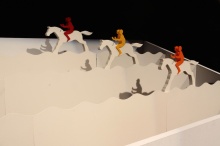
| |
| Description | PostInteractive Horse Race |
| Author(s) | A.B. (Bilex) |
| Platform | Gallop |
Information[Bearbeiten | Quelltext bearbeiten]
Kentucky Derby is a modification of the well known fun fair game of the same title. In contrast to the original game, Kentucky Derby provides a genuine interactive situation while concealing the definite mechanism of interaction and feedback.
In the absence of an interface device the participants start to discover ways of interaction to speed up their horse in order to become a winner. The movement of the horses is neither random nor they are controlled by an algorithm that is proccessing sensor-generated input data. Kentucky Derby works with a performative closed-loop system: The participants are observed by cameras and a person outside the room determines the game. Next to positive feedback (horse is going forward) the participants can be penalized by reversed movement, which is not possible in the originale game.
As most participants are familiar with interactive art, body and hand movement, clapping and shouting the color of the team they have chosen before, are common approaches to get into the inner working of the game.
Mechanics[Bearbeiten | Quelltext bearbeiten]
- Drive Concept
To get close to the original game, it is important to copy the silly action of the horses which mainly consists of head and tail movement. After rejecting several drive concepts using rods and wheels I decided to use a revolving timing belt. This solution is able to kill two birds with one stone: The belt is connected to the horse for forward motion, but on the way back it takes a roundabout way through the body to bring rotation inside the horse. All mechanics are hidden inside or behind the body to provide a magical effect of movement. "How is this working? I don't know, but it looks good!!"
- Linear Guiding
As there is no need for high precision or handling of high speeds or big loads, a plastic slide-guidance (Igus DryLin®-N 40mm) was chosen. Though there is no need for oil or grease, some WD40 means smoother operation. To save money most bearings are friction-based bearings that I got from IGUS as free samples. They work quiet nice, but mounting can be difficult. For proper operation the clearance of the bore needs to be very little.
- Motor
Kentucky Derby consists of three closed-loop stepper motors (Nanotec PD4-N6018L4204). As an integrated plug & drive motor, the complete electronics with the motor controller and encoder are contained inside a single housing. The motor can be controlled by sending ASCII-commands via RS-485. The integrated controller offers several functions like positioning, ramping, motor current and speed adjustment. Using industrial grade gear is not only fun, additional electronics and programming become obsolete. Only a few lines of code are required for sending ASCII-Commands via UART to get the motor running. To be honest, the chosen motor is a bit over-the-top.. it provides 3,55Nm of torque and a max. power of ~100W (@48V /375rpm). As the torque is quiet big, the current for proper operation can be lowered to 30% of rated current without losing steps or running into other problems. In operation with little current the motor sound is decreased. When running the motor detached from the mechanics it is super-silent, but after mounting it on the wooden frame, the resonances and vibrations are amplified dramatically. At least, Kentucky Derby can be quiet loud in operation! Things to learn here: Use mechanical-decoupling to keep resonances inside the motor. Using such a damper might help..?
CAD & Manufacturing[Bearbeiten | Quelltext bearbeiten]
Kentucky Derby was designed with Autodesk Inventor. The horses were done with the CNC-Fräse and are made out of 19mm MDF. To achieve a homogenous and glossy finish, several layers of primer and paint were applied. The riders (3mm plexiglass) and the wave-style track cover (3,5mm MDF) were laser-cut. Most mechanical parts were manufactured with the help of the workshop of the physics department at my university.
Electronics[Bearbeiten | Quelltext bearbeiten]
As the used motors have their own control units, the amount of additional electronic components is very little. A Teensy-Board is used to communicate with the motors. It receives data via USB and sends ASCII-Commands to the RS-485 bus. A MAX490 converts the UART output of the uC to RS-485 standard. To take a picture of the winner, a small reed-relais triggers a DSLR camera when a horse is crossing the finish line. To avoid long USB cables a OpenWRT based Wifi TCP/USB link is established. (See helpful links for more information!)
Competitors & Winners...[Bearbeiten | Quelltext bearbeiten]
... while being part of Kentucky Derby. Everyone is eager to finish first!
Video[Bearbeiten | Quelltext bearbeiten]
There are two videos available:
A TRAILER and footage of a reference run
Thanks to...[Bearbeiten | Quelltext bearbeiten]
... these companies which supported this project by providing discount or free samples:
- Nanotec GmbH Steppermotors!
- MÄDLER GmbH Great shop for machine parts like pulleys, gears..!
- IGUS GmbH Low-Budget linear guides!
















